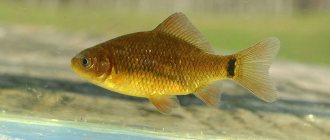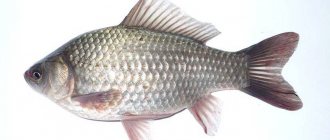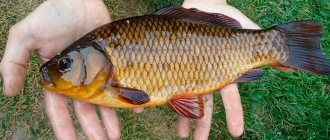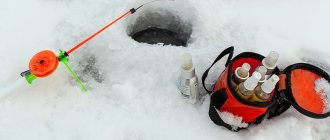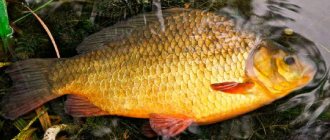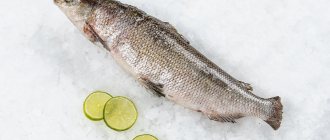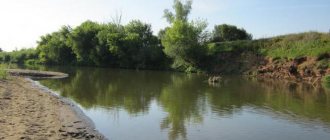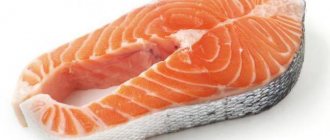Description and characteristic features of golden crucian carp.
Many fishermen know crucian carp, but gold carp is caught very rarely these days. This type of crucian carp is the natural species, from which other varieties have already evolved. Golden crucian carp are very careful fish. Golden crucian carp is a member of the carp family. It differs from carp in the absence of antennae at the mouth and the color of its scales. Golden crucian carp reaches 40 cm in length and weighs up to 1.5-2 kg, in contrast to silver carp, which can reach a length of 45-50 cm and weight up to 3.5 kilograms.
Golden crucian carp develops more in height and grows much slower than silver crucian carp. The body of the golden crucian carp is compressed laterally and strongly curved in height. Its back is dark bronze, and its sides are naturally golden in color. Some individuals are bright orange, which depends on living conditions. The scales are large and clearly marked in color.
This species is very hardy and unpretentious to water. This is one of our fish that can survive in water with a minimum amount of dissolved oxygen (0.6-0.5 cc/l). The minimum amount of oxygen is far from the only achievement of crucian carp for survival in our waters. He is able to survive in an ordinary puddle. But unlike silver crucian carp, golden crucian carp is not found everywhere.
Mostly, golden crucian carp can be found in forest lakes and abandoned peat mines. There is some kind of cyclical development of the crucian carp population in these places. For about 5-6 years, the golden one has a strong presence on large individuals, but after a few years, it seems to become smaller. It is also characteristic of this fish that in some ponds there are only a small number of females. Crucian carp eggs are also fertilized by males of other fish species.
Crucian carp shows amazing adaptability to the temperature of the water in which they live. With no less success, they are found both in the warm waters of reservoirs and in the cold waters of rivers and lakes. In winter, especially in shallow ponds, crucian carp get stuck in the mud and go into suspended animation. If the winter is very cold and the pond can freeze to the bottom, this saves them from death. In general, this is the hardiest type of fish, it is even compared to a cat, which also has nine lives. Wrapped in wet newspaper, crucian carp can survive for up to two days.
Habitats of crucian carp
Very extensive habitat. Golden crucian carp lives in most of Eurasia, the fish is widespread, but it is a less common species in comparison with silver crucian carp.
Golden crucian carp is a resident of small lakes, ponds and oxbow lakes. Crucian carp gravitate to places with aquatic vegetation.
The fish is even more unpretentious to the oxygen regime of the reservoir than silver crucian carp, so it can be caught much more often in small swamps and overgrown lakes. Golden crucian carp leads a bottom-dwelling lifestyle.
It rarely enters open areas in search of invertebrates and their larvae.
Crucian carp is undoubtedly the most unpretentious and undemanding fish. This circumstance determines its great industrial use in areas where there is an abundance of standing water, which constitutes the main habitat of this species.
Crucian carp lives in varying numbers not only in lakes and ponds, but is also often found in semi-underground lakes, almost completely covered in quagmire. They are also found in small holes, seemingly where it would be completely unthinkable for any other fish to live.
We can even positively state that the worse the water quality and the more silt in a pond or lake, the more favorable the environment for their living. Tina is the best for them.
Here they obtain food consisting only of organic remains and particles, small worms. During the winter, they completely bury themselves in the muddy bottom and survive in severe snowless winters, when small lakes freeze to the very bottom.
Golden crucian carp are generally much more resilient compared to silver crucian carp. Hence it is clear why now you rarely see a lake or other body of water where there are crucian carp.
Sometimes crucian carp suddenly appear in completely isolated pools. However, this circumstance can be easily explained by the fact that the eggs of crucian carp, stuck to the feathers of waterfowl, are easily carried to another body of water, and new young fish develop.
After a certain number of years, they multiply throughout the entire reservoir and the fishless lake, after 5 years it is teeming with crucian carp.
This beautiful fish lives in stagnant reservoirs, ponds, and oxbow rivers with a muddy bottom overgrown with aquatic vegetation. The weight of goldfish in these reservoirs can reach 2.5-3.5 kg. Golden crucian carp can also be found in forest lakes with a sandy bottom, but large specimens, as a rule, are not found there.
Where to catch crucian carp.
We have been fishing for many years, but we still cannot understand the logic behind the activity of crucian carp. You can catch a lot of fish one day, but return to the same place the next day and not see a single bite at all. Of course, this happens with other types of fish, but crucian carp is something special about the capriciousness of fishing. Only on the basis of where there is an overpopulation of crucian carp can we talk about guaranteed success in fishing. However, in these areas, in turn, it is very difficult to expect large samples - more than 1 kg.
Of course, there are several areas where such mining can be assumed. In most cases, they have warm lakes with a large number of large predatory fish that knock out small crucian carp. Thus, it is more likely to find golden crucian carp in some hidden lakes located far from populated areas and hidden in hard-to-reach places.
You can also bet on small, isolated shallow bodies of water, but there is a 1:10 chance that you will find goldfish there. Most likely, you will come across its hybrid, in particular the silver crucian carp. Interestingly, typical small backwaters are not suitable for fish such as bream, roach and carp, as there is very little food for them.
Apparently goldfish can use other food sources and, most importantly, there are periods that are less favorable for other types of fish, for example, extreme heat. Also remember that goldfish can survive winters when the water freezes to the bottom (I'm no expert, but I heard somewhere that crucian carp can produce oxygen from their fat reserves).
I’ll tell you one case that amazed me about the vitality of crucian carp. Once I received crucian carp from a friend in several small plastic bags. I thought they were dead (they had been without water for a long time and did not move). I put the bags of fish in the refrigerator. The next day I would like to use them to catch pike perch. Arriving fishing, so that the fish would not spoil ahead of time, I filled a bucket with water from the lake and poured the crucian carp into it. What was my surprise when after a while, almost all the individuals came to life and began to swim in the water. They were more than 24 hours without water!
Fishing for crucian carp.
When you find a good area where golden crucian carp lives, it is not a fact that you can catch it. It is imperative to determine a place suitable for fishing. It is best if it is close to the shore and at a depth of 2, maximum 3 meters. Crucian carp are rarely found in open water and generally avoid depth. It prefers to be caught in shallower areas of the lake, in areas where there is some silt or mud. There must be the presence of reeds and other aquatic plants. You need to cast the bait as close to the vegetation or into algae windows as possible. Anglers consider the so-called windows in the seaweed to be a favorite place for catching crucian carp. In the tangle of algae, the crucian carp feels calm. These windows in a continuous carpet of algae give some kind of calm to the fish, despite the real fact that one after another they disappear, falling into our gear. As a rule, good windows for catching crucian carp are created by fishermen themselves, using them constantly. So, if you want to catch crucian carp using ready-made windows, you must be at the fishing spot early in the morning to get a good spot.
There is one peculiarity in catching golden crucian carp. This view never stands in one place. Therefore, after catching a dozen crucian carp, the bite may stop. You should move to another place and re-feed. The fish will begin to gather in a new place again. This probably happens because goldfish are very careful fish.
During fishing, we create some noise, and the fish apparently feel that the number of comrades has decreased. And as a result, a flock of crucian carp leaves this dangerous place. But again it begins to gather in another place. During a day of fishing, with a good bite, you can change a dozen places. Perhaps instinctively the crucian carp is looking for another place of food source.
Fishing Features
Fish are caught mainly with float-type fishing rods, using bloodworms, worms, bread crumbs or pieces of dough as bait. Crucian carp reacts well to odors, so aromatization of the bait with flax, anise, hemp, mint, and laurel oils is successfully used.
In different water areas, fish differ in taste preferences.
Silver, for example, often loves the red worm.
For fishing, the deep parts of the reservoir, which border on overgrown shallow water, are preferred. Crucian carp are taken both from half-water and from the bottom layer, and directly from the surface layer. Fish is changeable in this regard, and one time it can be caught well at depth, and another time it can only be caught from the bottom. You need to find out at what level the bite begins and focus on it.
If in the middle of the summer period the catch of crucian carp is insignificant, then in the period after spawning the fishing goes simply “with a bang.”
The best time for fishing for crucian carp is morning or evening. Fishing is especially successful in good, calm weather.
Golden crucian carp is a less common species among crucian carp. Many ways have been invented to catch it. The most popular are feeder donka, float tackle, winter and summer jigs.
Catching crucian carp using feeder gear
Crucian carp can be caught with the simplest gear, but when fishing from the bottom you should give preference to a feeder. These are “bottom” equipment, most often using feeders.
The feeder and picker are convenient for most, even inexperienced anglers. They allow the fisherman to be quite mobile on the pond, and thanks to the possibility of targeted feeding, quickly “collect” fish in a given place.
Feeder and picker, as separate types of equipment, currently differ only in the length of the rod. The basis is the presence of a bait container-sinker (feeder) and replaceable tips on the rod.
The tips change depending on the fishing conditions and the weight of the feeder used. Fishing baits can be of any kind: both plant and animal origin, including pastes.
This fishing method is available to everyone. The tackle does not require additional accessories and specialized equipment.
This allows you to fish in almost any body of water. It is worth paying attention to the choice of feeders in shape and size, as well as bait mixtures.
This is due to the conditions of the reservoir (river, pond, etc.) and the food preferences of local fish.
Catching crucian carp with a float rod
It is during spawning periods that crucian carp are caught using nets and other gear. In many reservoirs, most crucian carp are caught using wall meshes.
Such fences are usually placed near the reeds where, according to experience, they go to spawn. When the place and time are chosen successfully, such a number of fish are caught that the net literally goes to the bottom.
There are cases where up to 10 pounds of excellent fish are taken out of any mesh in one morning.
In addition, large numbers of crucian carp are caught at different times of the year, excluding winter, in the snout device. An oblong cone-shaped jug woven from willow branches is called a muzzle, top or nerot. In the middle of a wide cone-shaped hole, a throat is woven from twigs like a funnel, so that the fish can freely pass into the muzzle, but cannot get out.
Some fishermen put some kind of bait, such as bread, in such gear. You can even catch crucian carp in a laundry basket tightly closed with matting or a lid with a hole about 2 inches in diameter. Place a bag of cottage cheese in this basket, then put it in water, placing a stone, usually overnight.
Groundbait and bait for crucian carp.
Crucian carp is a characteristically bottom-dwelling fish. His main rule is to look for food by digging at the bottom in the mud. At the same time, crucian carp will not miss larvae, worms, small leeches and even small fish. This is a frankly omnivorous fish. In the warm season, crucian carp graze with visible pleasure in algae or feast on young shoots of sycamore and reeds.
This happens mainly in the evening, and in calm weather a clear slurping sound can be heard throughout the pond. First of all, we find a quiet deep bay on the lake. We throw five or six large, orange-sized balls of soaked bread into the chosen fishing spot, to which we add a little clay for cloudiness. As a rule, after half an hour, crucian carp begin to gather at the feeding site. Then we only need to regularly toss small balls of bait with added bait, which is used to catch crucian carp.
As a rule, goldfish are well caught using bait of animal origin: dung worms, maggots, dragonfly larvae, shitika and other insect larvae. Large crucian carp are sometimes well caught on boiled or canned corn and peas. But it is best to use animal bait.
If the crucian carp takes very poorly and slowly, try catching it with a croissant or a couple of maggots. You can try other baits designed for catching other carp fish. Do not use hard baits such as sweet corn, wheat or oatmeal as bait. These baits are good for bait, since it is difficult for crucian carp to bite such hard food. Crucian carp loves soft baits.
Thus, it can be assumed that crucian carp prefers food of animal origin; it will be more picky about plant foods. To better attract crucian carp, you need to add maggots and chopped worms to the bait. It is good to add bone meal, which with its strong smell perfectly attracts a school of crucian carp.
Vegetable bait for crucian carp should only be very soft and in small pieces, such as pellets of bread or very soft dough. Of course, we can assume that large crucian carp can be caught using larger and harder bait. But still, the ideal and best bait for crucian carp would be an earthworm, as well as a dung worm.
Features of development
Golden crucian carp has amazed many fishermen with its appearance. It is distinguished by the beautiful golden color of its scales. Individuals of this species have an almost round body with a small tail and a small head. The fins of this type of fish are quite small. This is due to the fact that individuals do not mix over long distances. Juveniles have a small dark spot near the caudal fin. After reaching puberty, the spot disappears.
Crucian carp is considered a small fish. The weight of an average individual does not exceed 500 grams. Of course, some fishermen managed to catch large specimens, weighing up to three kilograms. Quite large crucian carp are found in the Cheboksary Reservoir. The average lifespan of representatives of this species is 10 years, but specimens that have reached 15 years of age are often caught.
The diet of crucian carp greatly affects its weight. That is why in those reservoirs in which the population is high, the weight of individuals is quite low. This is due to lack of food. Individuals mainly feed on small insects and larvae.
Tackle for catching crucian carp.
The most common way is to catch crucian carp using a fishing rod with a float. In this case, it is enough for us to fish with a lightweight universal telescope without drivers. The main line can be thicker - about 0.16-0.20, but the leash is always thin - 0.12. Hooks for catching crucian carp need white colors No. 14 - No. 10.
If we want to expand the perimeter of catching crucian carp and make long casts, a telescope with a reel is suitable. With this version of the fishing rod, use a removable float. The thickness of the main line is in the range of 0.16-0.20, use the same leashes and hooks as for a float rod. Sinkers are installed at a distance of 25-30 cm from the hook.
When fishing for crucian carp in reservoirs, use tackle with two leashes about 15 cm long. With this fishing method, the main line can be up to 0.24-0.30 thick, but the leashes must be made up to 0.14 thick. There is another fishing option: catching crucian carp from the bottom. We are talking about classic cake fishing. In this case, bottom tackle is used to catch carp and bream.
Habits of crucian carp throughout the year
As you know, nature in our region lives according to its own laws, and the year here is divided into winter, spring, summer and autumn. And fish are no exception. The behavior of crucian carp and the catch largely depend on the season.
Winter
At this time, most fish are inactive. The temperature of the water drops and it becomes covered with ice. Photosynthesis processes slow down, and therefore the amount of oxygen in the water decreases. Plants that begin to die in the fall fall to the bottom by winter and begin to decompose, forming a thick layer of silt. As a rule, if a reservoir does not have underwater springs, stream confluences, or currents, the crucian carp in such places will be inactive or inactive. It burrows into the silt for the winter, where it spends the cold months under the ice.
If in the wintering place of the crucian carp there is a small current that carries with it dissolved carbon dioxide from the rotting of plants, the crucian carp can remain active in such places. It comes to life on those days when melt water gets under the ice during winter thaws. These days come in mid-to-late March, when the most successful crucian carp fishing from the ice occurs.
Spring
Comes with the release of ice from the reservoir. At this time, the pre-spawning feast of crucian carp begins, which is preparing to spawn. The fish gather in schools, which can be of different colors or formed according to the size of the individuals. Populations of crucian carp can have different sexual compositions, sometimes there are hermaphrodite individuals, sometimes crucian carp is represented only by females, sometimes there are populations of different sexes. One way or another, before spawning, the fish in the reservoir try to stay together.
Fishing takes place in fairly warm areas. The warmer the water, the more active the bite will be. Just before spawning, in May, the largest crucian carp are caught. The fish prefers a fairly large active bait. You can fish with a summer jig, a float rod, or bottom tackle. It is most successful in areas with shallow depths, but a little further from the shore, where the fish are not afraid of the angler.
Summer
A characteristic feature of the summer period is the overgrowing of water bodies, and in the later stage, water blooming. Crucian carp begins to spawn in early summer, when the water warms up to 12-15 degrees. It spawns in shallow water areas, in bushes and reeds, where there is something to rub against to release the egg sacs. Often, artificial spawning grounds are tires thrown into the water in city ponds, fragments of piles and concrete products, and supports for bridges of walking paths in parks.
Spawning of crucian carp takes a long time; the same individual spawns several times. The largest crucian carp spawn first, then the smaller ones.
At this time, its bite is quite capricious; crucian carp can be caught on different baits throughout the day, rarely giving preference to any one.
Spawning ends only with flowering water in August. By this time, the fish begins to move away from spawning and actively eats aquatic insects and larvae, which reproduce in abundance by this time. August is the best time for fishing for crucian carp.
Autumn
With the arrival of cold weather, daylight hours shorten and the water temperature drops. The crucian carp begins to move away from the shores, where the water manages to cool down greatly during the night. However, not too far, as it is usually not so easy to see and forage at depth. The fish moves to places where they intend to spend the winter. Unlike many species of fish, crucian carp continues to be caught with a regular float rod until frost.
As a child, the author caught crucian carp instead of school until about October. The matter usually ended with the fishing rod being taken away after complaints to the parents. Now no one is taking away the fishing rod, and you can catch it until December using fly-float tackle.
Still, it is worth recognizing that the greatest interest in the autumn is fishing for crucian carp using bottom gear. They allow you to effortlessly deliver the nozzle quite far and are not too complicated. The main obstacle to using donkey in crucian carp areas is this aquatic vegetation. By autumn there is less of it, and bottom fishing is more accessible.
With the appearance of ice edges, the crucian carp practically stops biting. Its bite can only be activated with the complete formation of ice, when the surface of the water ceases to be cooled by the wind and the water becomes warmer.
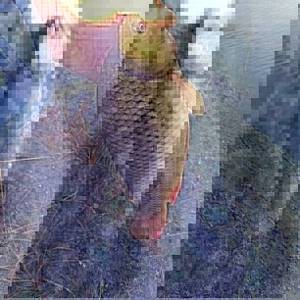
How the crucian carp bites and the visibility of the bite.
The golden crucian carp has a small mouth. He slowly and carefully tries the bait he likes. Sometimes, especially with bakery baits, he can fiddle with it for an indecently long time, creating the appearance of a bite. When fishing for crucian carp, you can often observe how the float trembles slightly and sways from side to side. A crucian carp approached the bait and carefully tried it.
However, on wild lakes, golden crucian carp does not stand on ceremony for a long time. His bite is similar to the swift blow of a perch; he grabs the bait with a running start and tries to quickly hide with it in a secluded place. If your reel clutch is poorly adjusted or the line is too thin, a break will naturally follow. When fishing for crucian carp on forest lakes, you must always be on alert.
Golden crucian carp is a very strong fish, unlike silver crucian carp. Under no circumstances should the line be slack. The goldfish has an upper fin like a razor blade. Sensing a slack in the tension of the tackle, it immediately turns over around its axis, thereby cutting your line with its dorsal fin. Another way of biting involves smoothly moving the float to the side. The crucian bite is similar to the line bite. Also, the float can suddenly lie on the surface. In such cases, you need to immediately hook the crucian carp.
Promising fishing spots
You can catch crucian carp in almost any body of water; it is not at all necessary to choose water areas with crystal clear water, with only shallow water or significant depths. The cyprinid representative thrives both in small silted lakes and in the backwaters of large rivers with minimal flow, but the presence of vegetation and snags is mandatory for its normal existence. The nature of the bottom can be ignored; sandy and clayey-silty areas will become a refuge with equal success. But the fish avoids great depths; the maximum crucian carp can sink no more than 3-4 m.
Victoria Leshchenko
I've been working hard in the fishing tackle department for the past six years. I can help you assemble almost any gear.
Ask a Question
When fishing, you should avoid places with strong currents; crucian carp do not like it. But thickets of reeds, pondweed, and sedge are exactly what will attract this ichthyan in the summer heat. In the spring, fish come out to the shallows to bask; most often small fish splash around here. Catching crucian carp in winter is almost impossible; it falls into suspended animation, practically does not feed or move, or simply buries itself in the silt waiting for better times.
Fishing for crucian carp.
Golden crucian carp is a strong fish. And since he has a small and very weak mouth, you must very carefully try to bring him to the landing net. Since this fish is mainly caught in overgrown ponds and lakes, there are difficulties in guiding it through algae and vegetation. The crucian carp is constantly trying to escape into the grass. If he succeeds, he is the winner of the fight. It is almost impossible to pull a crucian carp out of the grass. This must be taken into account when catching and playing.
However, the same size as carp or carp, crucian carp is still at least two times weaker than them, but fights quite intensely. The most important thing after hooking is to not let the crucian carp go into the thickets of grass or reeds and keep the line constantly under tension. When catching larger specimens we need to be more careful.
After resting a little, the crucian quickly gets tired and lies flat on the water. Here we can celebrate victory with confidence. Although there were cases that at the moment of putting fish into the landing net, a large crucian carp made a final push, and often broke off the leash, since the fisherman was already in a relaxed state, having decided that his catch was already in the cage.
When does crucian carp bite?
Crucian carp are heat-loving, for normal life they need a water temperature of +15, at 10 plus their metabolism decreases significantly, they stand almost motionless at the very bottom, it is almost impossible to tempt them with a tasty treat. Depending on the season and temperature of the water in the reservoir, fish will be caught in different ways:
- With the onset of freeze-up and gradual warming of the water, crucian carp will begin to become active; at first they can be seen close to the coastline on shallows and beaches, then with an increase in temperature they will move a little deeper. Large individuals will become more active later, but as soon as the weather stabilizes, there will be no frost in the morning, and the spawning period is getting closer, they will show interest in almost any bait offered.
- In the summer, after spawning, the crucian bite will be stable. Only the phase of the moon can influence it, but partially, and sudden changes in weather conditions.
- At the beginning of autumn, if it is warm, crucian carp will still be active. As the temperature drops, the fish will begin to fall into suspended animation. With the appearance of the edge of ice on the reservoir, the crucian carp will go down to the wintering hole and will wait for the onset of spring warmth there.
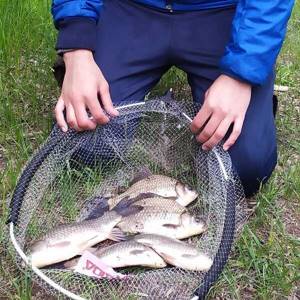
In winter, you can try to catch this representative of cyprinids from the ice, but how to catch crucian carp in winter? First of all, you need to wait for a significant thaw, and only then go to catch them.
Crucian carp fishing - conclusions.
Despite the widespread prejudice and even disdain of some fishermen towards crucian carp fishing as a serious fishing activity, many specifically look for hidden places to catch gold crucian carp. This species of crucian carp is now becoming very rare. If you compare catching gold with silver, these are two big differences. Golden crucian carp is very interesting in terms of fishing.
Firstly, it can be said that it is a rare fish, and secondly, in terms of its beauty and active resistance, golden crucian carp can be compared with the carp’s wild brother - the carp. Under good circumstances, such as the discovery of a lake or pond with golden crucian carp, the right choice of bait and fishing location, the catch can be very significant. In general, this is a fish worthy of respect, without big complaints, although many fishermen do not perceive crucian fishing as serious fishing.
Culinary qualities of crucian carp.
The meat of golden crucian carp is very tasty, unlike silver crucian carp. This is probably because golden carp is a wild fish, lives in clean waters and eats natural food. Crucian carp is very tasty in any cooking method. It’s not for nothing that our great-grandfathers loved this dish – crucian carp in sour cream. I tried it myself more than once. Real jam!
Small crucian carp up to 100 g, fried whole on both sides. Cut larger ones in half along the spine. This way they become thinner and cook better, and the bones soften better. Very large crucian carp are baked in an oven or on a grill, since the meat between the ribs is considered the most delicious. Unlike silver crucian carp, golden crucian carp does not have a specific taste of mud and algae, since it lives in clean lakes and feeds mainly on animal food. For a delicious taste, it is good to soak crucian carp in milk before frying.
And, finally, a pleasant feature of crucian carp - often in the catches there are, for some reason, female crucian carp, which have a lot of caviar all year round. Crucian caviar is no different from carp caviar. After removing the caviar from the fish, peel it. Wash and dry it, then salt it and put it in a jar. Keep in the refrigerator for about 2 weeks until the caviar takes on an orange-golden color.

